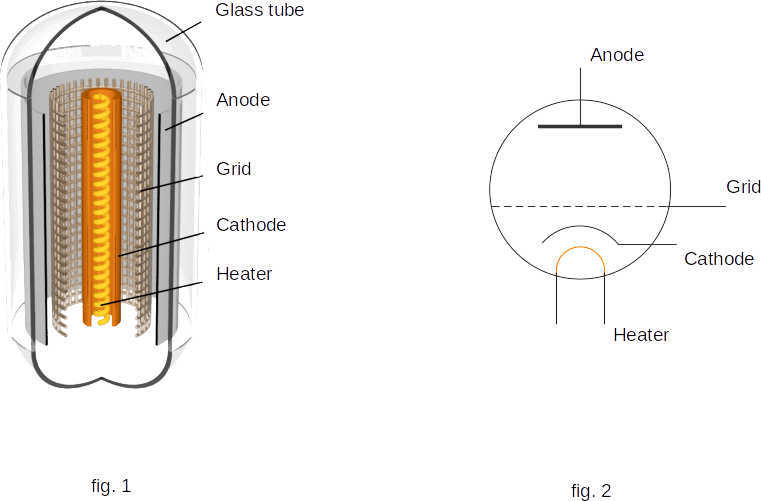From the Electrical current in different environments
113. Triode
The force of the electric current flowing through the electron tube is very much dependent on the density of the space charge of the electron cloud located directly near the cathode. Therefore, it is easier to control the electric current using additional electrodes located in this area. When a potential difference is created between the additional electrodes and the cathode, an electric field is created which has a strong influence on the space charge and therefore on the number of electrons reaching the anode.
The simplest tube of this type is the triode - a three-electrode electron tube. The triode has one additional electrode - the grid. It is placed between cathode and anode much closer to the cathode. The name itself indicates that this electrode is not solid and therefore it transmits electrons flying from cathode to anode.
In most electronic tubes, the grid is a wire frame in the form of a round or oval screw line, fixed on racks (fig. 1). The triode symbol is shown in figure 2.

Among the voltamper characteristics of the triode, the most interesting is the dependence of the anode current \(I_a\) (electric current through the tube) on the grid voltage \(U_g\) (potential difference between the grid and the cathode). A typical grid characteristic of the triode at constant anode voltage (potential difference between the anode and the cathode) is shown in figure 3. This characteristic can be obtained using the circuit shown in figure 4. It can be seen from the characteristic that electric current passes through the tube even at negative potential on the grid.

The anode current stops (the tube is locked) if the potential on the grid is less than a certain value depending on the tube device and the anode voltage. The voltage between the grid and cathode at which the tube is locked is called the closing voltage.
When working triodes in various radio engineering devices, a straight line section of the voltamper characteristic is particularly valuable. In this section, the same increments \(~ \Delta{I_a}\) anode current are obtained at the same increments \(U_g\) grid voltage. If we wanted to change the anode current to the same value by changing the anode voltage at a constant grid voltage, the \(U_a\) increments in absolute value would have to be many times greater than the corresponding \(U_g\) increments. This property of the triode allows its use in tube amplifiers and generators.